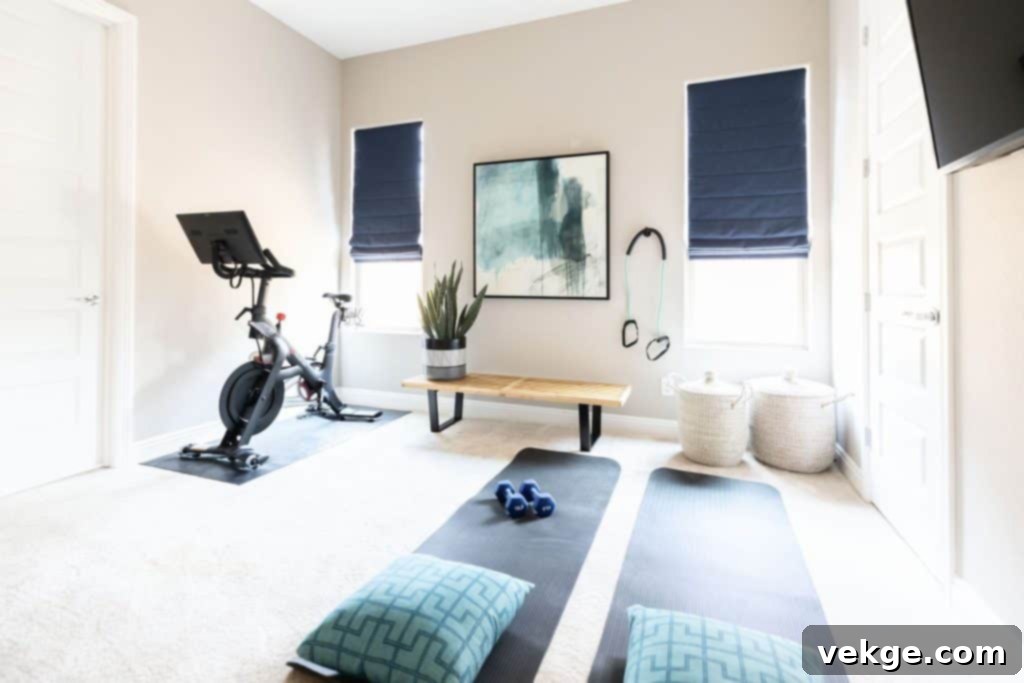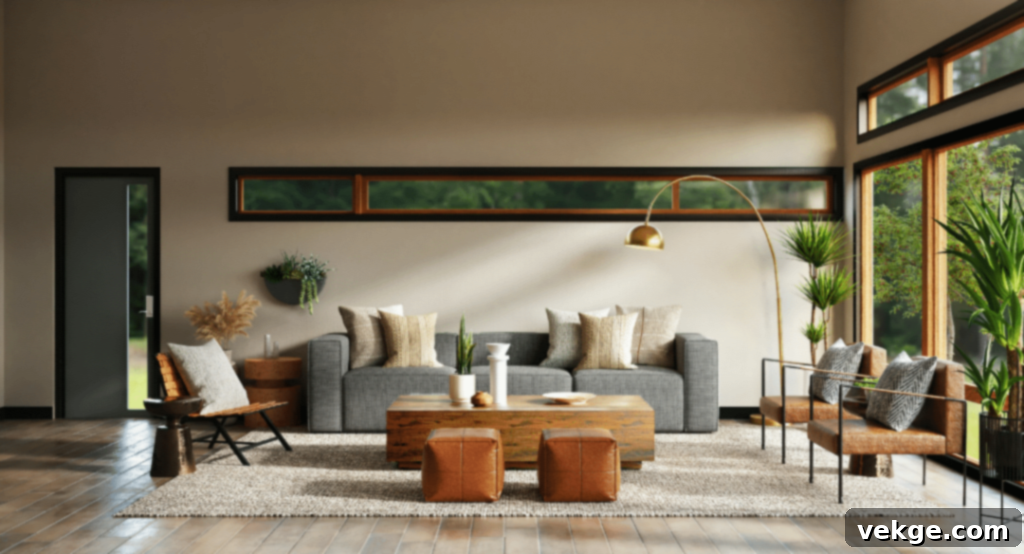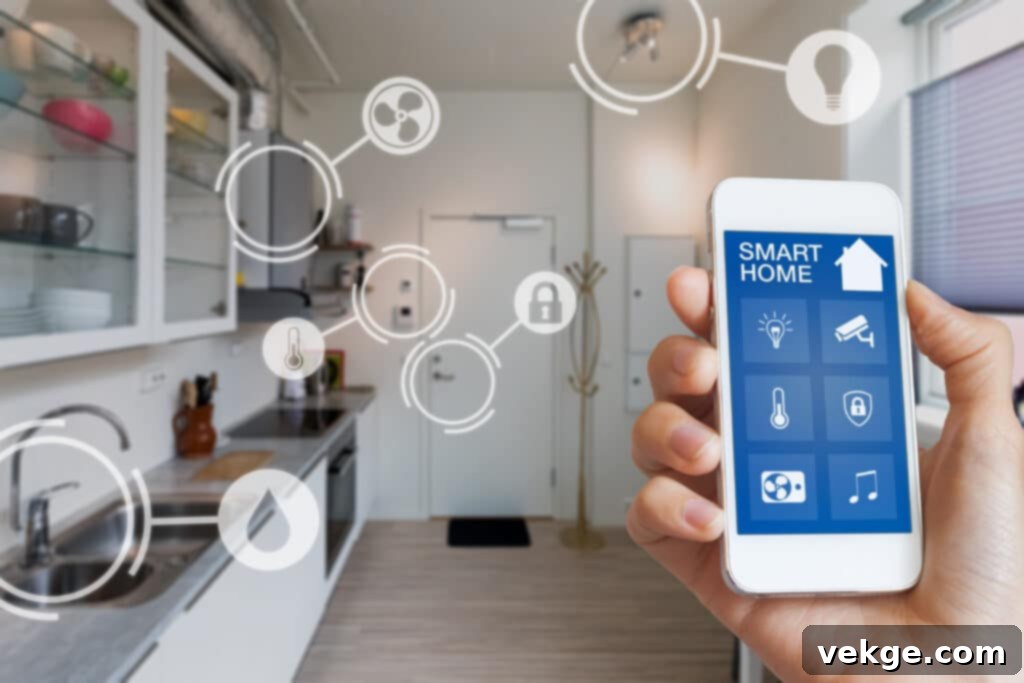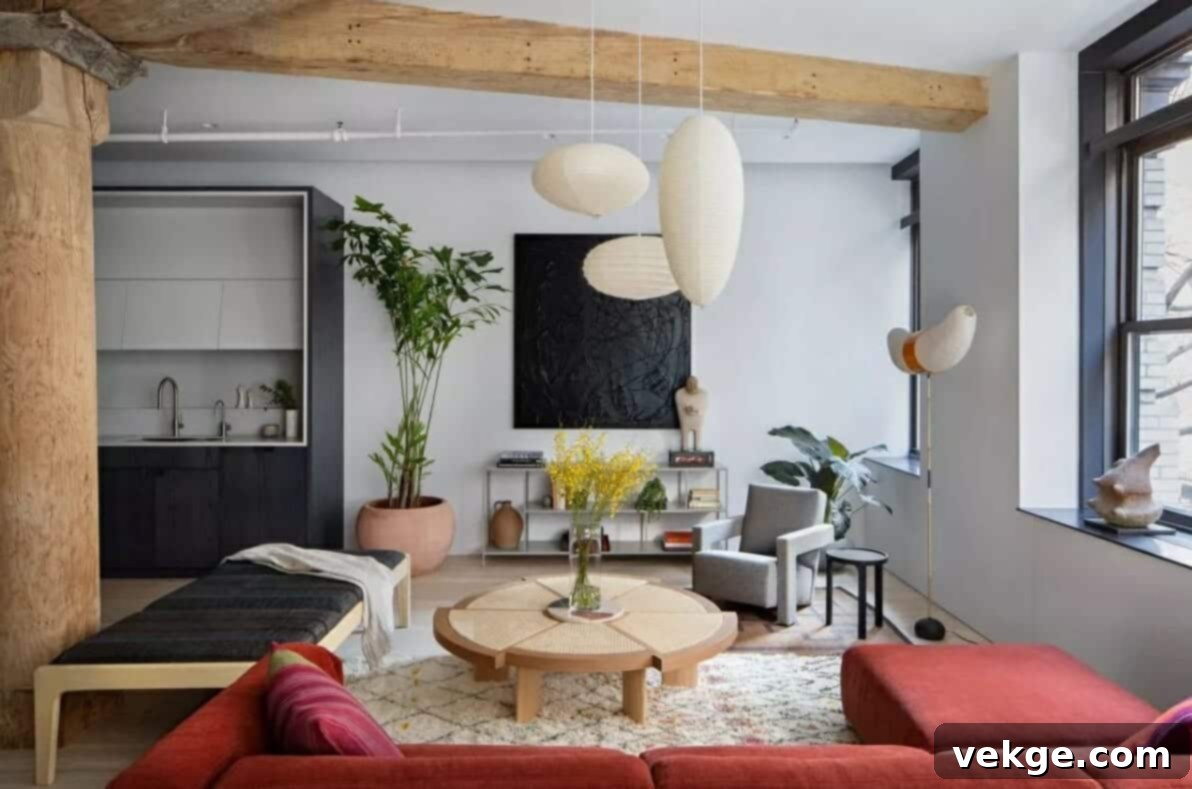Transform Your Home: Modern Upgrades for a Healthier & Happier Living Space
In today’s rapidly evolving world, a house is far more than just a structure of four walls and a roof. It’s a sanctuary, a workspace, a hub for family life, and a reflection of our aspirations for well-being. Thanks to continuous technological advancements and a growing understanding of holistic living, exciting home upgrades have emerged that can do more than just beautify your space. These innovations can fundamentally transform your home into a healthier, more functional, and profoundly more enjoyable environment for everyone who lives there. It’s time to elevate your living space from a mere dwelling to a truly dream home, fostering both physical and mental wellness.
Maximize Natural Light for Enhanced Well-being

If you’re embarking on a new home build or sketching out blueprints for a future renovation, resist the urge to skimp on windows and skylights. There’s an undeniable magic to natural light, and a home thoughtfully designed to harness the sun’s rays will always feel more vibrant and inviting. Maximizing natural light isn’t just about aesthetics; it’s a cornerstone of biophilic design, connecting us with the outdoors and profoundly impacting our mood and energy levels.
Consider the orientation of your home and how the sun’s path will illuminate your living spaces throughout the day. With strategic planning, you can enjoy abundant, free natural light, significantly reducing your reliance on artificial lighting and saving on energy bills. Beyond cost savings, exposure to natural light helps regulate our circadian rhythms, promoting better sleep patterns, and naturally boosts Vitamin D production. Furthermore, a well-lit space often feels more expansive and welcoming, making every corner of your home a pleasure to inhabit. Thoughtful integration of windows and natural ventilation can also contribute to improved respiratory health, particularly beneficial for those managing conditions like nocturnal asthma, by ensuring fresh air circulation.
Integrate Advanced Water Features and Filtration Systems
Water quality is an aspect many homeowners can significantly improve, often with surprisingly budget-friendly solutions. While municipal water in many developed countries, like the United States, adheres to high safety standards thanks to robust treatment infrastructure, “safe to drink” doesn’t necessarily mean optimal. Water, being the universal solvent, inevitably picks up trace materials, chemicals, and contaminants as it travels to your tap.
Installing a certified water filtration system is a proactive step towards safeguarding your family’s health and preserving your home’s plumbing. These systems work tirelessly to remove impurities that can affect not just taste and odor, but also long-term health. When selecting a system, prioritize options that include both sediment filtration and activated carbon. Sediment filters tackle larger particles like rust and dirt, while activated carbon is highly effective at reducing chlorine, disinfectant by-products (like trihalomethanes), and volatile organic compounds (VOCs), all of which can impact water quality, taste, and even shower steam.
For homes with particularly hard water, a water softener is a wise investment, protecting appliances from limescale buildup and improving the feel of your skin and hair after washing. For the purest drinking and cooking water, a reverse osmosis (RO) system installed under your kitchen sink offers an unparalleled level of purification, removing even microscopic contaminants for truly pristine water.
Embrace Non-toxic Materials for a Healthier Indoor Environment
 While seemingly obvious, implementing a truly non-toxic material strategy can be more challenging than it sounds due to the pervasive use of synthetic chemicals in modern consumer goods and building materials. The sheer number of novel compounds and human-synthesized toxins in our environment is alarmingly high, making it difficult for the average person to discern all potential dangers.
While seemingly obvious, implementing a truly non-toxic material strategy can be more challenging than it sounds due to the pervasive use of synthetic chemicals in modern consumer goods and building materials. The sheer number of novel compounds and human-synthesized toxins in our environment is alarmingly high, making it difficult for the average person to discern all potential dangers.
Educating yourself on common and hazardous toxins, such as volatile organic compounds (VOCs), formaldehyde, phthalates, and flame retardants, is crucial. Prioritize buying lead-free paints, and opt for glues, sealants, and solvents that are explicitly labeled VOC-free. Look for natural materials like solid wood, natural stone, bamboo, and cork for flooring and furnishings. When choosing insulation, consider options like cellulose or mineral wool instead of fiberglass. By making conscious choices, you significantly reduce the release of harmful chemicals into your indoor air, contributing to a much healthier living environment for you and your loved ones.
Enrich Your Space with Indoor Plants
No man-made artifact can ever fully capture the simple elegance, timeless beauty, and invaluable biological utility of a living plant. If you’re looking to refresh and revitalize your living quarters, incorporating green, growing things is an unparalleled choice. Plants do more than just add aesthetic appeal; they are natural mood boosters, known to reduce stress and improve concentration. Crucially, they perform vital air purification, absorbing carbon dioxide and releasing life-giving oxygen.
The presence of living greenery creates a unique, calming atmosphere. A house full of plants feels distinctly different from a sterile, plant-free space. This connection to nature, known as biophilia, nurtures our innate desire to be surrounded by living systems, fostering a sense of peace and vitality. Consider air-purifying plants like snake plants, peace lilies, or spider plants for added benefits, or aromatic herbs like rosemary and mint to engage the senses.
Ensure Optimal Ventilation for Fresh Air
 Good air circulation and proper ventilation are paramount for a healthy home environment. Beyond preventing dust accumulation, robust airflow allows inhabitants to breathe easier, minimizes the risk of mold and mildew growth (especially in humid areas like bathrooms and kitchens), and helps to refresh stale air, eliminating lingering odors from cooking, pets, or tired furniture and carpets. Stagnant indoor air can be a breeding ground for pollutants, making effective ventilation a crucial component of indoor air quality.
Good air circulation and proper ventilation are paramount for a healthy home environment. Beyond preventing dust accumulation, robust airflow allows inhabitants to breathe easier, minimizes the risk of mold and mildew growth (especially in humid areas like bathrooms and kitchens), and helps to refresh stale air, eliminating lingering odors from cooking, pets, or tired furniture and carpets. Stagnant indoor air can be a breeding ground for pollutants, making effective ventilation a crucial component of indoor air quality.
Simple actions like opening windows regularly are often sufficient. However, for those in heavily polluted urban areas, or during extreme weather conditions where opening windows isn’t feasible, mechanical ventilation systems offer a solution. Consider installing exhaust fans in bathrooms and kitchens, or exploring energy recovery ventilators (ERVs) or heat recovery ventilators (HRVs) for whole-house air exchange without significant energy loss. These systems bring in fresh outdoor air while expelling stale indoor air, crucial for maintaining optimal indoor air quality.
Incorporate Ergonomic Furniture for Comfort and Health
Furniture has the power to either enhance or detract from a room’s functionality and aesthetic. When planning a new home or renovation, consider furniture choices and layouts simultaneously with your floor plans. The goal is to integrate sofas, chairs, tables, and desks seamlessly, ensuring they complement the space without disrupting natural foot traffic or overwhelming the room with jarring colors or designs.
Beyond aesthetics, prioritizing ergonomics is key to creating a truly healthy home. Ergonomic furniture is designed to support the human body in a natural posture, minimizing strain and promoting comfort, especially important for those who spend a lot of time working or relaxing at home. Invest in comfortable, supportive chairs for your dining area, a well-designed desk chair for your home office, and sofas that offer good lumbar support. The careful selection and placement of furniture contribute to an organic aesthetic unity, where every piece serves both a practical and a visually pleasing purpose. Ensure colors and materials harmonize with your walls, floors, and countertops, creating a cohesive and inviting atmosphere that also accommodates anticipated guests comfortably.
Designate a Dedicated Exercise Area
 For fitness enthusiasts, a designated home exercise area is an invaluable asset. But even if you don’t frequent the gym, carving out a specific space for physical activity can be a powerful motivator to cultivate better habits. The convenience of having equipment readily available eliminates barriers and excuses, making it easier to integrate movement into your daily routine.
For fitness enthusiasts, a designated home exercise area is an invaluable asset. But even if you don’t frequent the gym, carving out a specific space for physical activity can be a powerful motivator to cultivate better habits. The convenience of having equipment readily available eliminates barriers and excuses, making it easier to integrate movement into your daily routine.
Even a modest 30 minutes of exercise every other day can significantly contribute to maintaining health, boosting energy, and improving overall quality of life. Modern solutions offer many ergonomic and space-saving workout options. Consider a foldable walking treadmill that can be stowed under a bed or in a closet, a set of versatile kettlebells or adjustable dumbbells that offer a wide range of exercises within a minimal footprint, or simply a yoga mat and some resistance bands. Transforming a spare corner, a section of a basement, or even an underutilized guest room into a dedicated fitness zone underscores a commitment to personal well-being.
Embrace Calming Colors for a Serene Ambiance
Our surrounding environment exerts a profound psychological influence. Clutter in our workspace can indeed lead to mental clutter, and overly bright or busy colors can create visual noise, acting as a subtle yet persistent source of stress and distraction. To foster a sense of peace and tranquility, consider painting your walls in calm, neutral colors.
Shades like eggshell, ecru, soft greys, muted blues, or gentle greens are not only generally easier on the eyes but also provide a sophisticated and understated backdrop. This allows your personal touches – art, family photographs, and decorative items – to stand out without competing with the walls themselves. Calming colors promote relaxation, reduce visual fatigue, and contribute to an overall sense of harmony and serenity, making your home a true haven from the outside world’s hustle and bustle.
Install Advanced Air Purifiers
 For anyone who has experienced the misery of seasonal allergies, suffered a reaction to mold spores, dust mites, pet dander, or other airborne contaminants, the profound benefits of an air purifier are undeniable. Breathing can become a constant struggle if you reside in a perpetually wet or marshy climate, or if your local environment is plagued by high levels of pollution.
For anyone who has experienced the misery of seasonal allergies, suffered a reaction to mold spores, dust mites, pet dander, or other airborne contaminants, the profound benefits of an air purifier are undeniable. Breathing can become a constant struggle if you reside in a perpetually wet or marshy climate, or if your local environment is plagued by high levels of pollution.
A high-quality air purifier, particularly one equipped with true HEPA filters and activated carbon, can transform your home into a bastion of clean, breathable air. These devices effectively capture microscopic particles, allergens, odors, and even some volatile organic compounds, drastically improving indoor air quality. You’ll likely notice a significant improvement in your breathing, leading to better sleep quality and overall enhanced well-being. Smart air purifiers can even monitor air quality and adjust their operation automatically, providing continuous protection without constant manual adjustment.
Optimize Your Home for Noise Reduction
In our increasingly dense and connected world, a quiet home environment is a luxury worth investing in. Soundproofing your living spaces, or at least incorporating noise-reducing materials into your walls, windows, and floors, can significantly enhance comfort and tranquility, especially if you live in a bustling city or a high-traffic area. The struggle of a new parent trying to lull a baby to sleep amidst blaring neighborly music or constant street noise is a common scenario that highlights the value of sound reduction.
Techniques range from adding insulation to interior walls, installing double-pane or laminated windows, using solid core doors, or even incorporating acoustic panels and heavy drapery. These measures help to dampen external noise and prevent sound from traveling between rooms, creating serene pockets for rest, work, or quiet enjoyment. For residents in dense urban housing, strategic sound reduction isn’t just an upgrade; it can be a boon for peace of mind and overall quality of life.
Choose Natural Fabrics for Comfort and Sustainability
 Many of the fabrics prevalent today are synthetics, largely derived from petroleum-based plastics. These materials can sometimes irritate sensitive skin and often lack the breathable quality of natural fibers. If you’re committed to minimizing synthetic materials in your immediate environment, fabrics are an excellent place to start. Opt for natural fabrics like cotton, linen, wool, hemp, or silk for everything from clothing and bedding to upholstery and curtains.
Many of the fabrics prevalent today are synthetics, largely derived from petroleum-based plastics. These materials can sometimes irritate sensitive skin and often lack the breathable quality of natural fibers. If you’re committed to minimizing synthetic materials in your immediate environment, fabrics are an excellent place to start. Opt for natural fabrics like cotton, linen, wool, hemp, or silk for everything from clothing and bedding to upholstery and curtains.
These natural fibers offer superior breathability, comfort, and often greater durability. They are also generally more sustainable and biodegradable than their synthetic counterparts. By choosing natural fabrics, you not only create a more comfortable and skin-friendly home but also reduce your exposure to microplastics and support environmentally conscious manufacturing practices. This simple shift can make a tangible difference in the overall health and feel of your living space.
Cultivate Inviting Outdoor Living Spaces
One of the most beneficial actions we can take for our well-being is to regularly immerse ourselves in fresh air and sunshine. Even if you don’t possess an expansive backyard, you can still maximize and utilize whatever outdoor space is available to you. Transform a small balcony into a serene retreat with potted flowers, aromatic herbs, or a compact seating area. A window planter box bursting with greenery can bring nature closer, even in an urban apartment.
For those with larger yards, consider developing a dedicated patio, deck, or garden space. Incorporate comfortable outdoor furniture, ambient lighting, and perhaps a small fire pit or water feature to create an inviting extension of your indoor living. These outdoor havens provide ideal spots for morning coffee, evening relaxation, social gatherings, or simply a moment of quiet contemplation. Furthermore, active participation in community gardens or frequent visits to local parks are excellent ways to ensure you regularly connect with nature, reaping its myriad mental and physical health benefits.
Designate Tech-Free Zones for Connection
In an age dominated by screens and constant digital connectivity, deliberately creating “tech-free zones” within your home is a powerful way to foster quality family time, deepen interpersonal connections, and protect mental well-being. It’s essential to periodically power down all devices and engage in meaningful, uninterrupted conversations and activities.
Consider designating the dining room as a device-free space where meals become opportunities for genuine interaction. Bedrooms can also be transformed into sanctuaries for rest and relaxation, free from the distractions of glowing screens, promoting better sleep hygiene. While technology offers immense benefits, its pervasive presence can easily overtake our lives, impacting our attention spans, sleep patterns, and overall mental health if left unchecked. Establishing these boundaries helps to reclaim moments for reading, board games, creative pursuits, or simply enjoying each other’s company without digital interruptions.
Seamlessly Integrate Smart Home Technology
 The landscape of smart home technology is vast and ever-expanding, offering a plethora of options from video doorbells and smart thermostats to intelligent lighting systems and automated security. While some advanced home tech might seem intrusive or overly complex, you don’t need to adopt a “camera-in-every-room” approach to reap the benefits of modern smart home design.
The landscape of smart home technology is vast and ever-expanding, offering a plethora of options from video doorbells and smart thermostats to intelligent lighting systems and automated security. While some advanced home tech might seem intrusive or overly complex, you don’t need to adopt a “camera-in-every-room” approach to reap the benefits of modern smart home design.
Strategic integration of smart tech can significantly enhance convenience, energy efficiency, and security. Smart thermostats learn your preferences and optimize heating and cooling, saving energy. Smart lighting systems allow you to control ambiance and even simulate natural light cycles, supporting your circadian rhythm. Automated security systems provide peace of mind. Many smart devices can be controlled via voice commands or a central hub, simplifying daily routines. The key is to choose smart home solutions that genuinely improve your daily life and comfort, balancing technological advancement with thoughtful consideration for privacy and ease of use.
Plan for Effortless Cleaning and Maintenance
Designing or organizing your living space with easy cleaning in mind can save you countless hours and considerable frustration in the long run. Thoughtful material choices and layout decisions can drastically minimize tough cleaning jobs and recurring maintenance. For instance, while wall-to-wall carpeting can feel cozy, it’s a notorious magnet for dust, allergens, pet dander, and spills, often requiring laborious steam cleaning. Anyone who has deep-cleaned a carpet understands the effort involved and what unsanitary elements it can harbor.
Opting for hard surface flooring like hardwood, laminate, tile, or polished concrete is a game-changer for cleanliness. These materials are significantly easier to sweep, vacuum, and mop, making routine cleaning a breeze and dramatically improving indoor air quality by reducing hidden allergens. Similarly, consider finishes for countertops and walls that are durable and easy to wipe clean. Incorporate smart storage solutions to reduce clutter, and choose furniture designs that allow for easy access underneath. By prioritizing low-maintenance design upfront, you save yourself future headaches and free up more time to enjoy your beautifully maintained home.
The Bottom Line: Craft Your Ideal Living Space
Modern homeowners are empowered with more options than ever before to craft an ideal, personalized, and health-conscious living space. The convergence of smart technology, advanced environmental solutions, sustainable practices, and thoughtful design principles allows for the creation of homes that are not just aesthetically pleasing but also profoundly supportive of well-being.
From harnessing the therapeutic power of natural light and ensuring pristine air and water quality, to embracing non-toxic materials, incorporating ergonomic comforts, and integrating intelligent smart home solutions, every upgrade contributes to a richer living experience. These elements, when woven together, transform a house into a sanctuary—a place where you thrive, relax, and truly love being. Invest in your home, and in doing so, invest in your health, happiness, and future.
